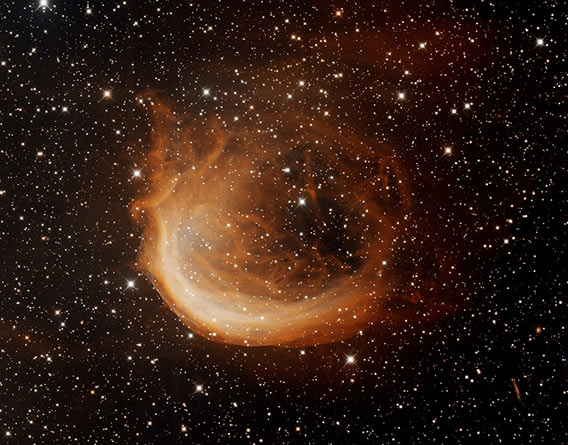Create a free profile to get unlimited access to exclusive videos, sweepstakes, and more!
The Firefox Nebula

If you live in the Northern Hemisphere and go outside around midnight in the summer, youâll see a big W made of five brightish stars in the northeast. Thatâs Cassiopeia, the constellation of the queen. Due to geometric circumstance, we are looking into the plane of our galaxy when we peer in that direction. That means weâre looking into a region of space that has more stars, more gas, and more dust than average.
Which means itâs a good place to look for interesting objects. And in fact itâs where you will find the gorgeous nebula Sharpless 2-188, the gas cast off by a dying star:
This image was taken by my friend Travis Rector (and Heidi Schweiker) using the Kitt Peak 4-meter telescope. They used two filters; one shows hydrogen gas (orange) and the other oxygen (cyan). I highly suggest you grab the 4,900-by-3,800 pixel version, or at least the 1,200-by-940 pixel image, because wow.
Sh2-188 is what we call a planetary nebula, a bit of a misnomer since the first that were discovered looked small, disk-shaped, and slightly greenish through a telescope. Now we know theyâre formed by the winds from dying stars, vast gales of gas expelled as the star sheds its outer layers and exposes its small, hot core. The leftover star, called a white dwarf, is so hot it blasts out ultraviolet light, enough to cause the gas to glow.
Planetaries come in fantastic shapes, mostly due to the way the wind from the star changes over time and interacts with previously blown-out material. But Sh2-188 is different, even by the standards of the planetary nebula menagerie. Itâs highly asymmetric. Even though you can see it makes a complete circle (well, oval), one side is far brighter and more interesting-looking than the other.
This is almost certainly due to the culprit star itself, screaming through space at high speed. Itâs not 100 percent clear which star is at the heart of this nebula, mostly because there are so many to choose from! But there is a faint star down to the lower left of the inside of the cloud, faint and not at all distinguishable by eye from any of the others, that is most likely the actual âcentralâ star. Itâs blueâexpected for the hot, dense, cinder needed to light up this gasâand about the right brightness.
Also as expected, measurements over time indicate the star is moving through space toward the lower left, probably at well over 100 kilometers (60 miles) per second. That would explain much of why this nebula is so asymmetric; as the star (and its wind) rams through the gas in space, the stuff in the direction of travel piles up, just like a snowplow pushing through snow. Itâs also possible that thereâs just more stuff in between the stars in that direction, so there is more material to pile up. But either way, the speed of the star is the major reason this planetary is so unusual.
I found this picture browsing through Travisâ gallery, and even before I read his description I thought to myself, âHuh. That looks familiar!â and sure enough, Travis had the same thought and mentioned it in the caption.
Does it look like the logo for any browser you might be using?
Once you see it, the resemblance is pretty good. I can see ears, a nose, the tail, even the foreleg! And while it may not actually be on fire, the surface temperature of the stars is far hotter than the Sun. Of course, itâs in the constellation of Cassiopeia, the queen, not Vulpecula, the fox, but still. At 60 trillion kilometers in diameter, it makes a heckuva logo.
Mozilla, you may have a new direction for your branding â¦
Related Posts:
The Flaming Skull Nebula. Seriously.
A Dying Star With the Wind in Its Hair
A Glowing, Bubbly Bauble in Space
A Star on the Edge of a Weird, Lovely Death
The Green Ghost of a Distant Dead Star














